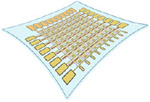Table 1.
Comparison of Conventional Rigid Sensors and Emerging Flexible Sensors
| Form factor/ appearance |

|

|
|---|---|---|
| Rigid sensors | Flexible sensors | |
| Performance | ||
| Stretchability | < 1%a,30 | Up to 1000%31,32 |
| Young’s modulusb,33 | 1–200 GPa | 10 kPa–200 GPa |
| Conformability on non-flat surfaces | No | Yes |
| Measurement during mechanical deformation | No | Yes |
| Manufacturing | ||
| Methods | MEMSc techniques | Printing, MEMS techniques, etc. |
| Scale27 | 0.01–0.1 m2 (wafer) | Up to 1–100 m2 (web)28 |
| Single-step throughput27 | 0.001−1 m2 min−1 | Up to 10–1000 m2 min−1d |
| Potential cost per unit area34 |
High |
Low |
| Carbon footprint | High | Low |
| Applications | ||
| Smartphones, autonomous vehicles, industrial robots, etc. | Conformal skin patches, smart textiles, sticker sensors for industrial IoT, supply chain, food, etc. |
Stretchability of rigid sensors is approximated as the fracture strains of conventional electronic materials. However, the real stretchability would be smaller taking performance alteration in consideration.
Ranges cover the Young’s moduli of common materials (packaging materials included) used in rigid and flexible sensors.
MEMS, microelectromechanical systems.
Assuming 1 m wide web on a roll-to-roll platform.
